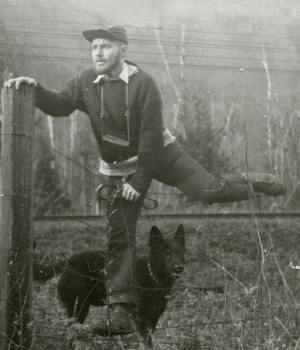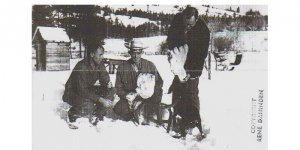(Historic) René Dahinden
René Dahinden was born on August 23, 1930, in the town of Weggis, Switzerland. He moved to British Columbia in 1953 where he heard a radio report about an upcoming 1954 Daily Mail expedition to the Himalayas to search for the yeti. As Rene Dahinden recalls, after listening to the CBS news broadcast, he turned to his boss, Wilbur Willich, and said, "Now wouldn’t that be something to be on the hunt for that thing?" Mr. Willich’s response would change Rene’s life forever; he said, "Hell, you don’t have to go that far. They got them things in British Columbia."
Dahinden was the first researcher to show the Patterson-Gimlin film in the former Soviet Union and he worked hard to see that the film got the scientific attention he felt it deserved. He wrote one book (with Don Hunter) during the course of his research entitled "Sasquatch," which was published in 1975.
In the award winning 1999 documentary Sasquatch Odyssey, Dahinden was portrayed as one of the Four Horsemen of Sasquatchery, along with Grover Krantz, Peter Byrne and John Green, a British Columbian researcher who joined René on many of his field excursions. Before he passed away Dahinden acquired rights to some of the photographic images from the Patterson-Gimlin film, a process that occupied much of his time in legal and copyright affairs. Today his estate still owns significant rights to the film.
René Dahinden died in 2001.
Published Works
Sasquatch (1975) - with Don Hunter
"Far from the swashbuckling mountaineers of the Yeti hunts of Asia, in North America the model of the dedicated, obsessive, amateur manlike monster hunter took the form of Swiss-born, Canadian René Dahinden (1930–2001). The irascible and original Dahinden entered the quest for Sasquatch upon his arrival in the New World and developed a reputation for being coarse and abrupt with anyone he thought a fraud or a fool: which in the end formed a rather long list. He regularly discounted scientists, whom he variously referred to as boffins and deadheads. To his credit, with no scientific or research training—in fact little formal education at all—he launched himself into the Sasquatch fray and tirelessly tracked down and documented witnesses and went to the sites of alleged direct encounters. Like many amateurs he secretly yearned to be an academic and live the life of an erudite scholar, but felt hurt, embittered, frustrated, and resentful of those who did: especially when most of them dismissed him. He sacrificed his family life and stability in order to continue his chase and never looked back or showed much public regret. Not as sophisticated as Bernard Heuvelmans, as well published as Ivan Sanderson, or as skilled a writer as John Green, he pursued other monster hunters as tenaciously as he pursued monsters. While eccentric, he was not an out-of-control paranormalist and approached his subject as rationally as any academic should. He represents a great lost opportunity in the history of science. He had the heart, but not the tools. A prime mover in the search for anomalous primates, he could lay claim, along with Green and Peter Byrne, to the title of 'grand old man of North American monster hunting'." --- B. Regal, Searching for Sasquatch

